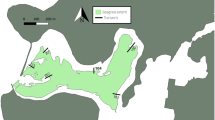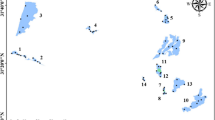Abstract
We analyzed multiple variables in recent sediments from 18 tropical, karst lakes in “Lagunas de Montebello” National Park, a Mexican Protected Natural Area and Ramsar site, to explore relationships between sediment characteristics and lake attributes: topography/location (mountain, surface-water-dominated vs. plateau, groundwater-dominated), morphometry (shallow vs. deep), and human activities (urbanization/agriculture). The study lakes fell into two groups: (1) pristine, oligotrophic, mostly located in the SE mountain terrain, and (2) impacted, eutrophic, in the NW plateau region. Sediment samples were collected from the central, deepest zone of each lake and analyzed for texture (grain size), carbonate content, and organic C and N. Water variables were measured in the water column overlying the sediment collection sites. Specific conductance, chlorophyll a, and total particulate carbon were higher in impacted, eutrophic plateau lakes than in pristine mountain lakes. Sediments, although composed mostly of silts, differed in grain size. Pristine, oligotrophic mountain lakes possessed coarser sediments, with a higher concentration of most likely recalcitrant organic carbon, than impacted, eutrophic plateau lakes. Topography/location is the primary factor that contributes to sediment differences, whereas eutrophication, caused by deforestation and agricultural runoff, is the second most important agent modifying sediment characteristics. The only pristine plateau lake, San José, had water quality similar to pristine mountain lakes, but finer sediments with lower organic C, N, and C/N. Comparison of San José sediments with those of impacted eutrophic plateau lakes indicated eutrophication has led to coarser sediments, as well as enrichment in CO3, organic C and N. Eutrophication-related sediment characteristics are valuable variables that can be used in paleolimnological studies to identify the onset of lake eutrophication in tropical karst water bodies.











Similar content being viewed by others
References
Alcocer J, Oseguera LA, Sánchez G, González CG, Martínez JR, González R (2016a) Bathymetric and morphometric surveys of the Montebello lakes, Chiapas. J Limnol 75:56–65
Alcocer J, Oseguera LA, Escobar E (2016b) Contenido de carbono elemental en sedimentos lacustres de un conjunto de lagos tropicales con distinto estado trófico. In: Paz Pellat F, Wong González J, Torres Alamilla R (eds) Estado Actual del Conocimiento del Ciclo del Carbono y sus Interacciones en México: Síntesis a 2016, Serie Síntesis Nacionales. Programa Mexicano del Carbono en colaboración con la Universidad Autónoma del Estado de Hidalgo. Texcoco, Estado de México, México, pp 357–365
Alcocer J, Merino-Ibarra M, Oseguera LA, Escolero O (2018) Anthropogenic impacts on tropical karst lakes: “Lagunas de Montebello”, Chiapas. Ecohydrology 11:e2029. https://doi.org/10.1002/eco.2029
Alvarado VJ (2017) Evaluación del transporte de sedimentos y la calidad del agua utilizando SWAT, en el Río Grande de Comitán, Chiapas. MS Thesis, UNAM, México
Arar EJ, Collins GB (1997) Method 445.0. In vitro determination of chlorophyll a and pheophytin in marine and freshwater algae by fluorescence. US Environmental Protection Agency, Cincinnati, USA
Caballero M, Vázquez G, Lozano-García S, Rodríguez A, Sosa-Nájera S, Ruiz-Fernández AC, Ortega B (2006) Present limnological conditions and recent (ca. 340 yr) palaeolimnology of a tropical lake in the Sierra de Los Tuxtlas, Eastern Mexico. J Paleolimnol 35:83–97
Caballero M, Mora L, Muñoz E, Escolero O, Bonifaz R, Ruiz C, Prado B (2019) Anthropogenic influence on the sediment chemistry and diatom assemblages of Balantetik lake, Chiapas, Mexico. Environ Sci Pollut Res. https://doi.org/10.1007/s11356-019-04581-9
Cohen AS (2003) Paleolimnology: the history and evolution of lake systems. Oxford University, Oxford
CONAFOR (2018) Inventario Nacional Forestal. Informe de resultados 2009–2014. Comisión Nacional Forestal, México
Costa-Böddeker S, Bennion H, Araújo de Jesus T, Albuquerque ALS, Figueira RCL, Bicudo DC (2012) Paleolimnologically inferred eutrophication of a shallow, tropical, urban reservoir in southeast Brazil. J Paleolimnol 48:751–766
Cortés-Guzmán D, Alcocer J, Oseguera LA (2017) 4.2. Biomasa de los macroinvertebrados bentónicos en el perfil batimétrico de lagos de Montebello, Chiapas, México. In: Pellat F, Torres Alamilla R (eds) Estado Actual del Conocimiento del Ciclo del Carbono y sus Interacciones en México: Síntesis a 2017. Serie Síntesis Nacionales. Programa Mexicano del Carbono en colaboración con el Centro de Investigación Científica y de Educación Superior de Ensenada y la Universidad Autónoma de Baja California. Texcoco, Estado de México, México, pp 159–165
Cooper SD, Lake PS, Sabater S, Melack JM, Sabo JL (2013) The effects of land use changes on streams and rivers in Mediterranean climates. Hydrobiologia 719:383–425. https://doi.org/10.1007/s10750-012-1333-4
Dedkov AP, Mozzherin Vl (1996) Erosion and sediment yield on the Earth. In: Walling DE, Webb BW (eds) Erosion and sediment yield: global and regional perspectives. Proceedings of the Exeter Symposium, IAHS Publ. No. 126, Exeter, UK, pp 29–33
Durán Calderón JI (2013) Análisis geomorfológico del Parque Nacional Lagunas de Montebello, Chiapas. BS Thesis, UNAM, México
Durán Calderón I, Escolero Fuentes O, Muñoz Salinas E, Castillo Rodríguez M, Silva Romo G (2014) Cartografía geomorfológica a escala 1:50000 del Parque Nacional Lagunas de Montebello, Chiapas (México). Bol Soc Geol Mex 66:263–277
Duru U, Wohl E, Ahmadi M (2017) Factors controlling sediment load in the Central Anatolia Region of Turkey: Ankara River Basin. Environ Manage 59:826–841. https://doi.org/10.1007/s00267-016-0818-8
Farley M (2012) Eutrophication in fresh waters: an international review. In: Bengtsson L, Herschy RW, Fairbridge RW (eds) Encyclopedia of lakes and reservoirs. Springer, Dordrecht, pp 258–270. https://doi.org/10.1007/978-1-4020-4410-6
Folk RL (1980) Petrology of sedimentary rocks. Hemphill Pub, Austin
Fontana L, Albuquerque ALS, Brenner M, Bonotto DM, Sabaris TPP, Pires MAF, Cotrim MEB, Bicudo DC (2014) The eutrophication history of a tropical water supply reservoir in Brazil. J Paleolimnol 51:29–43. https://doi.org/10.1007/s10933-013-9753-3
García E (1988) Modificaciones al sistema de clasificación climática de Köppen. UNAM, México
Itam AE, Inyang DO, Effiong MP, Ukot AA, Udoaka EO (2017) Textural characteristics of sediments along the Qua Iboe river/estuary bank, South East, Nigeria. IJRTER 3:198–207
Killops S, Killops V (2005) Introduction to organic geochemistry. Blackwell Publishing Ltd., Oxford
Knapp JS, Bromley-Challoner KCA (2003) Recalcitrant organic compounds. In: Mara D, Horan NJ (eds) Handbook of water and wastewater microbiology. Academic Press, San Diego, pp 559–595. https://doi.org/10.1016/B978-0-12-470100-7.X5000-6
Lewis WM Jr (2002) Causes for the high frequency of nitrogen limitation in tropical lakes. Verh Int Verein Limnol 28:210–213
López Rivera S (2017) Uso de fertilizantes nitrogenados en la cuenca del Río Grande de Comitán, ¿La lixiviación representa un problema ambiental? MS Thesis, UNAM, México
Lozano-García S, Caballero M, Ortega B (2007) Evidencia del impacto humano y cambio climático natural en la región de Los Tuxtlas, Ver.: un enfoque multidisciplinario. Tip Revista Especializada En Ciencias Químico-Biológicas 10:49–55
March Mitsuf IJ, Flamenco Sandoval A (1996) Evaluación rápida de la deforestación en las áreas naturales protegidas de Chiapas (1970–1993). El Colegio de la Frontera Sur, Mexico
Martínez AM (2015) Caracterización de los suelos de la Cuenca del Río Grande, como soporte para entender la dinámica de contaminantes que llegan al sistema lagunar de Montebello, Chiapas. BS Thesis, UNAM, México
Mora L, Bonifaz R, López-Martínez R (2016) Unidades geomorfológicas de la cuenca del Río Grande de Comitán, Lagos de Montebello, Chiapas-México. Bol Soc Geol Mex 68:377–394
Mota Covarrubias S (2019) Análisis hidrogeológico del agua subterránea de la cuenca del Río Grande de Comitán, Chiapas. MS Thesis, UNAM, México
Otu MK, Ramlal P, Wilkinson P, Hall RI, Hecky RE (2011) Paleolimnological evidence of the effects of recent cultural eutrophication during the last 200 years in Lake Malawi, East Africa. J Great Lakes Res 37:61–74
Olea-Olea S, Escolero O (2018) Nutrients load estimation to a lake system through the local groundwater flow: Los Lagos de Montebello, México. J South Am Earth Sci 84:201–207
Oseguera LA, Alcocer J (2015) Concentración y distribución vertical del carbono particulado (total y orgánico) en los lagos de Montebello, Chiapas. In: Paz Pellat F, Wong González J, Torres Alamilla R (eds) Estado Actual del Conocimiento del Ciclo del Carbono y sus Interacciones en México: Síntesis a 2015 Serie Síntesis Nacionales. Programa Mexicano del Carbono Centro del Cambio Global y la Sustentabilidad en el Sureste AC y Centro Internacional de Vinculación y Enseñanza de la Universidad Juárez Autónoma de Tabasco. Texcoco, Estado de México, pp 457–463
Rivera-Herrera EM, Vargas-Sánchez M, Alcocer J, Oseguera-Pérez LA (2019) 2.16. Impacto antrópico en la biomasa fitoplanctónica de lagos kársticos, Chiapas, México. In: Paz Pellat F, Velázquez A, Rojo M (eds) Estado Actual del Conocimiento del Ciclo del Carbono sus Interacciones en México. Síntesis a 2019. Programa Mexicano del Carbono en colaboración con el Centro Nayarita de Innovación y Transferencia de Tecnología, Universidad Autónoma de Nayarit, Consejo de Ciencia y Tecnología del Estado de Nayarit y Stanford University-México Economía Limpia 2050-USAID. Texcoco, Estado de México, México, pp 318–324
Rosenmeier MF, Brenner M, Kenney WF, Whitmore TJ, Taylor CM (2004) Recent eutrophication in the southern basin of Lake Petén Itzá, Guatemala: human impact on a large tropical lake. Hydrobiologia 511:161–172
Sobek S, Durisch-Kaiser E, Zurbrügg R, Wongfun N, Wessels M, Pasche N, Wehrli B (2009) Organic carbon burial efficiency in lake sediments controlled by oxygen exposure time and sediment source. Limnol Oceanogr 54:2243–2254. https://doi.org/10.4319/lo.2009.54.6.2243
Vera-Franco MN, Hernández-Victoria PP, Alcocer J, Ardiles-Gloria V, Oseguera LA (2015) Concentración y distribución vertical de la clorofila-a fitoplanctónica en los lagos de Montebello, Chiapas. In: Alcocer J, Merino-Ibarra M, Escobar-Briones E (eds) Tendencias de investigación en Limnología tropical: Perspectivas Universitarias en Latinoamérica. Asociación Mexicana de Limnología AC, Instituto de Ciencias del Mar y Limnología UNAM, y Consejo Nacional de Ciencia y Tecnología, México, pp 107–114
Veronesi ML, Barbieri A, Hanselmann W (2002) Phosphorus, carbon and nitrogen enrichment during sedimentation in a seasonally anoxic lake (Lake Lugano, Switzerland). J Limnol 61:215–223
Wentworth CK (1922) A scale of grade and class terms for clastic sediments. J Geol 30(5):377–392
Witt C, Rangin C, Andreani L, Olaez N, Martínez J (2011) The transgressive left-lateral Sierra Madre de Chiapas and its buried front in the Tabasco plain (southern Mexico). J Geol Soc 169:143–155
Zhu L, Shi W, Van Dam B, Kong L, Yu J, Qin B (2020) Algal accumulation decreases sediment nitrogen removal by uncoupling nitrification-denitrification in shallow eutrophic lakes. Environ Sci Technol 54:6194–6201
Acknowledgements
This research was funded by the Fondo Sectorial de Investigación y Desarrollo Sobre el Agua (Sectorial Fund for Water Research and Development) (CONAGUA-CONACYT) through the project 167603 Estudio Hidrológico y de Calidad del Agua del Sistema Lagunar de Montebello, en el Estado de Chiapas and by Dirección General de Asuntos del Personal Académico (UNAM-DGAPA-PAPIIT) through the projects IN219215 Factores que Determinan el Estado Trófico de los Lagos de Montebello, Chiapas and and IV200319 Área Experimental de Lagos Tropicales. We thank René Morales Hernández for support during the fieldwork. We also thank the Parque Nacional Lagunas de Montebello, Comisión Nacional de Áreas Naturales Protegidas (CONANP) the local community, and the Comisariados Ejidales from Antelá, Cárdenas, Miguel Hidalgo, Ojo de Agua and Tziscao for facilitating access to the lakes. We also thank the Comité de Administración de Tziscao, and personnel of the Villas Tziscao Hotel for offering their support and facilities for this study. We thank Mariana Sánchez Vargas for creating the charts in Figs. 1, 2 and 9.
Author information
Authors and Affiliations
Corresponding author
Additional information
Publisher's Note
Springer Nature remains neutral with regard to jurisdictional claims in published maps and institutional affiliations.
Supplementary Information
Below is the link to the electronic supplementary material.
Rights and permissions
About this article
Cite this article
Alcocer, J., Prado, B., Mora, L. et al. Sediment characteristics of tropical, karst lakes and their relationship with watershed topography, lake morphometry, and human activities. J Paleolimnol 66, 333–353 (2021). https://doi.org/10.1007/s10933-021-00210-z
Received:
Accepted:
Published:
Issue Date:
DOI: https://doi.org/10.1007/s10933-021-00210-z




